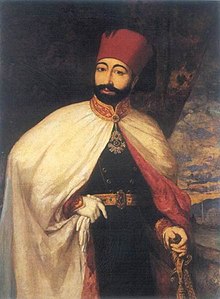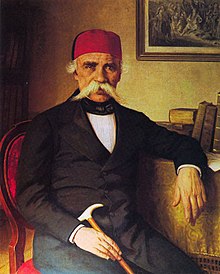The origins of the Fez are unclear and there are different theories. One of them is that the Fez may have originated in the
Balkans,
[5] or in
Greece,
[6][7] and subsequently spread to other places by the
Ottoman Empire.
Initially the Fez was a brimless red, white, or black bonnet over which a turban was wrapped (similar to a wrapped
keffiyeh). Later the turban was eliminated, the bonnet shortened, and the color fixed to red. Praying while wearing a Fez—instead of a headdress with brim—was easier because
Muslims put their heads to the ground during
Salah (daily prayers).
[8]

Portrait of the Ottoman Sultan
Mahmud II after his clothing reforms.
In 1826 Sultan
Mahmud II of the
Ottoman Empire suppressed the Janissaries and began sweeping reforms of the military. He
modernized military adopted Western style uniforms and, as headdresses, the fez with a cloth wrapped around it. In 1827, 50,000 fezzes were ordered from Tunis for the sultan's troops.
[9] In 1829 the Sultan ordered his civil officials to wear the plain Fez, and banned the wearing of
turbans.
[10] The intention was to coerce the populace at large to update to the Fez, and the plan was successful. This was a radically egalitarian measure, which replaced the elaborate
sumptuary laws that signaled rank,
religion, and occupation, foreshadowing the
Tanzimat reforms. Although tradesmen and artisans generally rejected the Fez,
[11] it became a symbol of modernity throughout the Near East, inspiring similar decrees in other nations (such as
Iran in 1873).
[10]

Ottoman soldiers wearing Fezzes during the
Greco-Turkish War (1897).
To meet escalating demand, skilled Fez makers were induced to immigrate from Tunisia to
Constantinople, where factories were established in the neighborhood of
Eyüp.
[9] Styles soon multiplied, with nuances of shape, height, material, and hue competing in the market. The striking scarlet and merlot colors of the Fez were initially achieved through an extract of
cornel. However, the invention of low-cost synthetic dyes soon shifted production of the hat to the factories of
Strakonice,
Czech Republic (then in the Austrian Empire).[
citation needed]
The 1908
Austro-Hungarian annexation of Bosnia-Herzegovina resulted in a
boycott of Austrian goods, which became known as the "Fez Boycott" due to the near monopoly the Austrians then held on production of the hat. Although the headdress survived, the year-long boycott brought the end of its universality in the Ottoman Empire as other styles became socially acceptable.[
citation needed]



